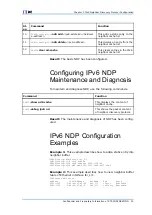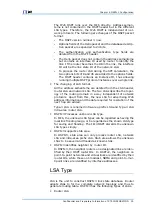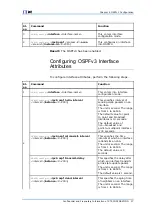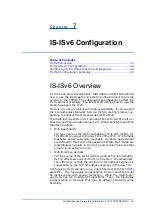
ZXR10 T600/T1200 User Manual (IPv6 Volume)
�
OSPFv3 processes protocol on link, not on subnet.
IPv6 uses the term of link to describe the facilities or mediums
used by nodes for communications over the link layer. Nodes
are connected with links. Multiple IP subnets can be attached
to the same link. Two nodes in different IP subnets can com-
municate with each other directly over a single link.
�
Address semanteme is deleted from OSPFv3.
The OSPF packet contains no IPv6 address except for the LSA
net load carried by link state update packet.
The router LSA and network LSA do not contain network ad-
dresses, and only indicate topology information simply.
The OSPF router ID and the LSA link state ID are reserved to be
the IPv4 32-bit, without being associated with IPv6 addresses.
�
OSPFv3 extends the range of flooding.
The LS field of the LSA reflects its flooding range. LSA features
the following three flooding ranges:
�
Link Local Range
LSA only floods in local links. This range is applicable to
the link LSA.
�
Area Range
The LSA only floods in a single OSPF area. This range is
applicable to the router LSA, network LSA, inter-area prefix
LSA, Inter-area router LSA and intra-area prefix LSA.
�
AS Domain Range
The LSA floods in the whole OSPFv3 route domain. This is
applicable to AS external LSA. Each link supports multiple
instances. OSPF supports to run multiple OSPF protocol
instances over a single link.
�
Usage of link local address.
The IPv6 link local addresses are used for neighbor discovery
and automatic configuration over a single link. IPv6 routers
do not forward the IPv6 packets containing link local source
addresses. The IPv6 address range that is allocated to the link
local unicast addresses is FE80/10.
Except for all OSPF interfaces in the virtual link, link local ad-
dresses related to interfaces can send OSPF packets as source
addresses. In the virtual link, only the IP address in the global
range or of a local site can serve as the source address.
The link local addresses occur in the LSA of OSPF link but are
not allowed to occur in other LSA types.
�
The changing of authentication on OSPFv3.
The authentication type and authentication field are deleted
from the IPv6 OSPF header.
All the authentication-related
fields do not occur in the OSPF area and the interface packet
structure.
The IPv6 OSPF employs IPv6-provided authenti-
cation mechanism to realize integrity and confidentiality in
packet exchanging.
�
The changing of packet format on OSPFv3.
34
Confidential and Proprietary Information of ZTE CORPORATION
Содержание ZXR10 T1200
Страница 5: ...Figures 71 Tables 73 List of Glossary 75 ...
Страница 6: ......
















































